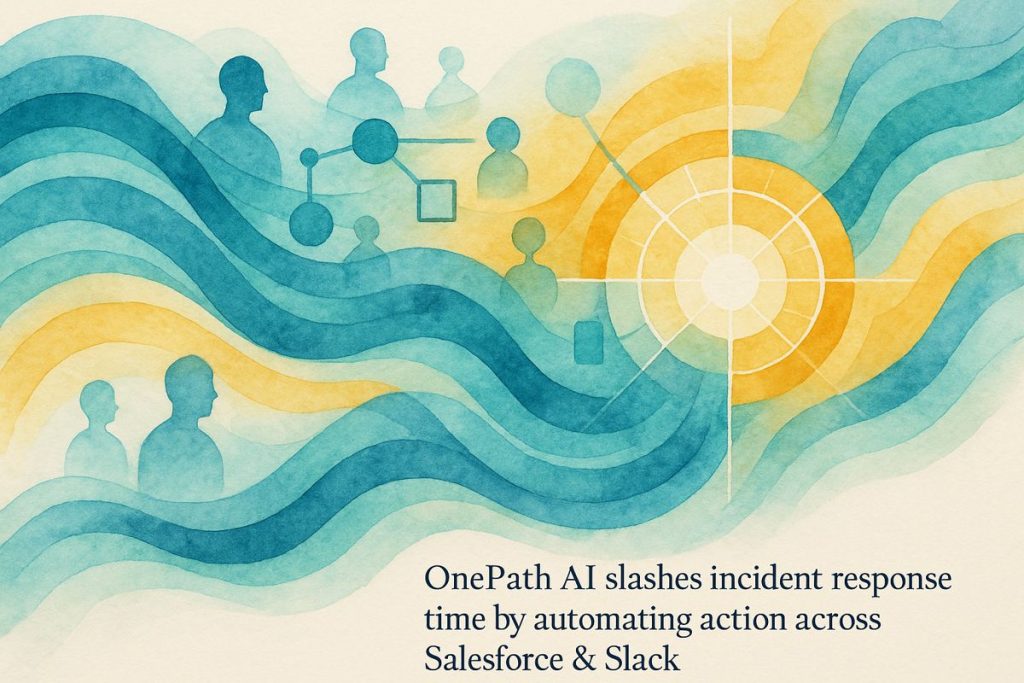OnePath AI transforms chaotic incident response into smooth teamwork by using Salesforce Agentforce to find the right people fast, create special Slack channels, and send clear updates. Instead of scrambling to contact everyone when things go wrong, everything is automated and organized in seconds. This smart system cuts down panic, saves time, and helps teams fix problems quicker. It’s like turning a messy garage band into a perfectly tuned orchestra, all powered by clever code and seamless integrations.
How does OnePath AI improve incident response using Salesforce Agentforce?
OnePath AI streamlines incident response by leveraging Salesforce Agentforce to automatically identify key stakeholders, create dedicated Slack channels, and deliver concise incident briefings. This automation reduces chaos, eliminates manual coordination, and accelerates resolution, making incident management more efficient within enterprise environments.
If you’ve ever found yourself frantically pinging six different colleagues at 2:03 a.m. because the production server just did its best impression of a submarine (i.e., sank fast and left bubbles), you’ll understand why I nearly spilled my coffee reading about OnePath AI. Let’s talk about how this brainchild of Cass Papadopoulos and Zachary Harwood didn’t just win the ‘Best Demo Delivery‘ trophy at the 2025 Salesforce Agentforce Hackathon—they effectively composed a symphony out of what’s usually a cacophony of incident response chaos.
What was their secret sauce? Automation, integration, and a dash of audacity, all engineered atop Salesforce’s Agentforce platform. And yes, Slack—the digital agora of modern work—features heavily in their tale.
Agentforce: A New Conductor in the Enterprise Orchestra
First, a little scene-setting. Salesforce rolled out Agentforce in October 2024, complete with fanfare and the obligatory press release. But what exactly is this Agentforce thing? In essence, it’s a hyperspectral agentic framework—think of it as a virtuoso conductor, not just directing but actually performing complex business processes across a medley of departments. Unlike the chatbots of yesteryear (looking at you, Clippy), Agentforce’s Atlas Reasoning Engine can weave its way through labyrinthine workflows, make decisions, and even correct its own mistakes without needing a human to tap it on the shoulder.
At the 2025 Hackathon, the stakes were palpable. With $140,000 up for grabs (thanks, SalesforceBen), the air positively crackled with ambition and late-night optimism. Developers, admins, and the occasional caffeine-fueled consultant—each vying not just for glory, but for bragging rights and, possibly, that elusive sense of having banished chaos from the business world.
I’ll admit: I had to stop and ask myself whether Salesforce’s bet on this kind of agentic architecture was a stroke of genius or just marketing hyperbole. But bear with me while we dig into OnePath AI’s approach.
Incident Response, Reimagined: The Mechanics of OnePath AI
When disaster strikes—say, a data pipeline hiccups or a critical API gives up the ghost—most companies lurch into action like a startled herd of zebras. There’s the frantic WhatsApp pinging, the deluge of “any update?” emails, and that one guy who always asks if you’ve tried turning it off and on again. OnePath AI, however, turns this whole ordeal into a tightly choreographed ballet. (Well, most of the time. There’s always that one unpredictable pirouette…)
Here’s how it works: The moment an incident is detected, OnePath AI leans on the Agentforce platform to identify key stakeholders faster than you can say “who’s on call?” Using a blend of Salesforce data, Apex logic, and custom flows, it instantly curates a list of the right people—no more all-hands-on-deck unless truly necessary. Then, in an act of digital alchemy, it spins up a dedicated Slack channel, invites those stakeholders, and deposits a laser-focused incident briefing. No fluff, no “see attached for details,” just the cold, hard facts in a format even the sleep-deprived can parse.
I remember when I once tried to coordinate a similar response manually—let’s say the results were less symphony, more garage band. I felt frustration (spiked with embarrassment) watching colleagues scramble because I’d tagged the wrong person on the wrong system. OnePath AI’s approach would’ve saved me a headache—and a sheepish apology. Bam!
For the curious, the proof is in the demo and the technical breakdown. There’s something oddly satisfying in watching those Slack channels blossom, each one a poppy in a field of digital weeds.
Nuts, Bolts, and Synapses: Technical Underpinnings
Let’s not be coy—the real wizardry is under the hood. At its core, OnePath AI is a palimpsest of Apex code, Salesforce Flows, and AI prompt templates designed to distill chaos into clarity. The system taps directly into Service Cloud and Slack using both standard and custom connectors. It’s a little like watching an old player-piano—but instead of ragtime melodies, you get incident briefings and actionable task lists, delivered in real time.
Notably, Harwood’s background in weaving together Slack–Salesforce integrations is evident. His handiwork ensures that notifications and handoffs glide smoothly, even when the rest of the world seems determined to trip over its own shoelaces. And Papadopoulos? His penchant for elegant automation—the kind that makes you squint, then nod in appreciation—shines through in the way Agentforce’s agents reason about who should be looped in, and when.
Oh, and a bit of sensory detail: I’m told the satisfying “pop” of a new Slack channel appearing in your sidebar is as much a signal of hope as it is of impending work. The digital equivalent of the aroma of fresh coffee—invigorating, yet slightly ominous.
Beyond the Hackathon: Ripples in the Industry Pond
You might be wondering—does this innovation have legs, or is it
